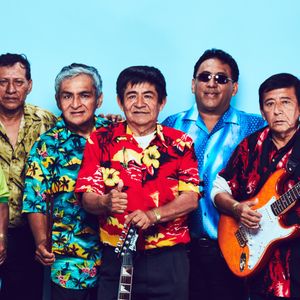

In 1968, in Iquitos, the capital of the Peruvian Amazon, shoemaker Solomon Sanchez decided to start a band with his five sons. They became the first group in the Amazon to play local rhythms using electric guitars, creating a new hybrid sound that greatly influenced South American popular music. Their songs, such as “Sonido Amazonico” and “Danza del Petrolero,” became iconic in the cumbia amazonica movement.
The brothers grew up in Iquitos, the largest isolated city in the world with nearly half a million residents, where the closest road is six days away by boat. The river and forest play a significant role in the culture, yet Iquitos remains a large urban center. The city’s unique culture is shaped by a blend of indigenous folklore and urban life, symbolized by the river dolphin and moto-taxi.
Their main connection to the outside world was through the radio, which exposed them to a variety of music, including Colombian cumbia, Brazilian carimbó, Ecuadorian sanjuanitos, Venezuelan joropos, and psychedelic rock, in addition to local rhythms like Tahuampa, Pandillas, and Criollo waltzes.
Los Wembler’s, driven by curiosity and a willingness to experiment, integrated these diverse styles into their music. They especially admired the electric guitar sound, particularly with a wah pedal, and covered songs by artists like Brazil’s Pinduca and Ecuador’s Polibio Mayorga. Cumbia became the most adaptable rhythm and the core of their music.
Their first tune, “Cumbia Amazonica,” gave its name to the genre they pioneered. The band’s name, Los Wembler’s, reflected both their traditional roots and foreign influences, combining the name of a local ethnic group, the Huambisa, with Wembley Stadium, adding an ‘s’ for a more rock and roll feel.
Los Wembler’s rise coincided with the oil boom, attracting high-paid oil workers known as petroleros who became fans of the band at their parties. Meanwhile, other Amazonian bands were also electrifying their music, but Los Wembler’s, drawing more heavily from Amazonian folklore, took longer to gain wider fame. Their music gained recognition beyond Iquitos when Los Mirlos, a band based in Lima, covered some of their tunes.
Throughout the 1970s, Los Wembler’s released up to two LPs a year and toured extensively in the Amazon and Peru’s major cities, becoming Iquitos’s greatest musical export. By the mid-1980s, cumbia amazonica’s popularity waned, replaced by techno cumbia. Los Wembler’s stopped recording and touring but continued to play locally at various events.
Fast forward twenty-five years, and young Peruvians, seeking to reconnect with their cultural roots after the Fujimori era, began rediscovering early rock and cumbia amazonica. In 2007, Barbès Records released “Roots of Chicha: Psychedelic Cumbias from Peru,” featuring Peruvian cumbia from Lima and the Amazon. This rekindled interest in Amazonian bands as a link between Latin roots and rock.
Los Wembler’s were rediscovered, performing in Lima in 2011 for the first time in twenty-five years. New Tropical Electronic musicians, such as Dengue Dengue Dengue, collaborated with them. In 2015, the Smithsonian invited them to perform at the prestigious Folklife Festival in Washington DC.
Today, Los Wembler’s continue to perform and record, maintaining their creative edge. Their early experiments with cumbia and indigenous rhythms were not mere chance but the work of skilled musicians attuned to their environment and curious about the world. The style they pioneered over forty years ago has found a global audience, and Los Wembler’s are committed to keeping it relevant through ongoing experimentation.

Leave a Comment